In a Conflict With China, Access to Indonesia's Straits Isn't Guaranteed
Allies cannot count on Jakarta adhering strictly to UNCLOS if it feels under pressure.

[By Michael Roach]
While the United States spends billions on military infrastructure from Guam to Darwin, one crucial enabler of Indo-Pacific deterrence remains noticeably underdeveloped: rights to pass through Indonesia.
The sea and air space of the archipelago would be hard to avoid in any regional conflict scenario. US and allied force planning has rightly focused on hardware and forward basing, but has it given enough attention to the challenge of regional access? In a crisis, the deciding factor may not be bombers or submarines, but whether Indonesia permits access and aligns politically with allied operations.
Without reliable passage through Southeast Asia, and Indonesia in particular, deterrence risks being operationally constrained, even where significant capability investments have been made. Heavy basing in Guam or northern Australia cannot offset gaps in force mobility across Southeast Asia, notably through strategic corridors such as the Sunda, Lombok and Makassar Straits. As regional tensions increase, it is this political gap, not a military one, that threatens the coherence of allied deterrence strategy.
The first challenge is structural. For decades, the US–Australia alliance has functioned on the implicit understanding that Australia operates in its near region while the US projects force further abroad. That model is now breaking down. As US military assets become more embedded in Australia through rotational deployments, submarine infrastructure and logistics hubs, allied operations will increasingly rely on transit through Southeast Asia. This shift has been formalized through agreements such as Submarine Rotational Force–West and ongoing AUKUS infrastructure projects, which deepen military integration but stop short of addressing transit pathways across the Indonesian archipelago. In any scenario requiring rapid mobilization, resupply, or joint force maneuvers, access through Indonesia would be indispensable.
Under international law, particularly the United Nations Convention on the Law of the Sea (UNCLOS), foreign ships and aircraft may transit Indonesian archipelagic sea lanes and exercise innocent passage through Indonesian territorial waters, even when a country that owns them is at war. But in practice this guarantee may prove unreliable. Jakarta has signalled its intent to regulate military transits beyond the scope of UNCLOS. In 2018 it issued a regulation requiring foreign aircraft to notify Indonesian authorities before passing.
After the AUKUS security partnership was announced, Indonesian member of parliament Tubagus Hassanudin said the sea lanes ‘cannot be used for activities related to war or preparation of war or non-peaceful activities.’
Strategic planning has not caught up with this operational reality of needing assured access through Southeast Asia. There is no shared framework between the US and Australia, nor between allies and key Southeast Asian partners, that maps out roles, thresholds or access guarantees in the event of conflict. This is particularly problematic given Indonesia’s longstanding policy of non-alignment: Jakarta will not automatically support Western operations and may actively resist becoming entangled.
Assuming Indonesian cooperation without laying the diplomatic groundwork is a critical flaw in current deterrence planning. Indonesian foreign policy under President Prabowo Subianto, while more globally engaged, continues to prioritize strategic autonomy, focusing on balancing ties with the US, China and others while avoiding formal alignment. This makes passive expectations of cooperation particularly risky in crisis scenarios.
Indonesia’s recent engagements, such as Prabowo’s meeting with Russian President Vladimir Putin in June to discuss strengthening bilateral ties and signing a declaration on strategic partnership, underscore Jakarta’s commitment to a non-aligned foreign policy. This meeting, which included discussions on defense cooperation and Indonesia’s full membership in BRICS, highlighted Indonesia’s intent to diversify its international partnerships beyond traditional Western alliances.
Australia and its allies should consider stress-testing their postures through scenarios that assume denied access through Indonesia, such as including blocked sea lanes or restricted overflight, to ensure strategic plans are resilient under less-than-ideal conditions. Without such planning, deterrence could be shaped more by assumptions than by operational realism.
Even if a formal closure of the sea lanes would breach international law, allies cannot count on Jakarta adhering strictly to UNCLOS if it feels under pressure—for example, if it perceives its neutrality or sovereignty is threatened. Political alignment remains critical alongside legal rights.
If deterrence is to be credible, it must appear coherent not only to adversaries, but to partners. A fragmented or poorly coordinated response increases the risk of miscalculation. Without visible regional alignment, even if informal, signals of allied resolve will lack traction. Indonesia is the key geopolitical node in Southeast Asia. If Jakarta hedges or remains neutral, others in the region may follow its lead. Conversely, quiet coordination with Jakarta would significantly enhance the legitimacy and operational reach of allied strategy
Deterrence in the Indo-Pacific is not built on bases and hardware alone. It will be shaped by access. While initiatives in Guam and Darwin strengthen allied presence, their full strategic value depends on enabling regional access, particularly through Indonesia. Real influence will hinge on strategic trust-building through defence dialogue and sustained, high-level engagement that respects Indonesia’s autonomy while offering tangible incentives for cooperation.
Moreover, Indonesia’s decision to join the BRICS bloc, announced in March, signifies a strategic pivot towards strengthening ties with emerging economies. It underscores Jakarta’s desire to play a more prominent role in global affairs, independently of Western-led frameworks.
A forward posture means little without a viable route through Indonesia. It is time for allied strategy to treat Southeast Asian access not as a convenience, but as a core requirement for regional stability.
Michael Roach is a management consultant and researcher. His research focuses on global economic, geopolitical and strategic defense trends.
This article appears courtesy of The Strategist and may be found in its original form here.
The opinions expressed herein are the author's and not necessarily those of The Maritime Executive.
